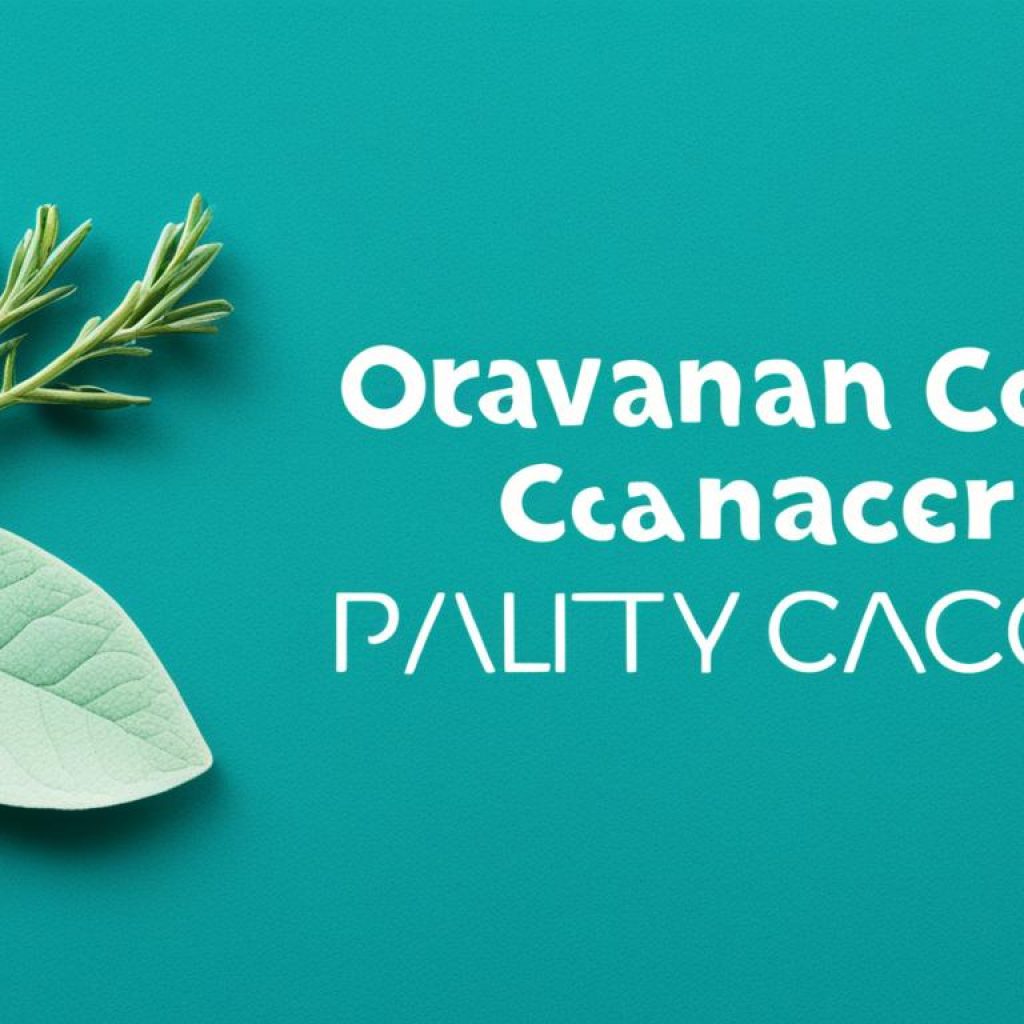Did you know that high-grade serous carcinoma, the most lethal type of ovarian cancer, is the fifth most common cause of cancer-related death for women in the U.S?
Ovarian cancer is a challenging disease that poses significant risks and limitations in diagnosis and treatment. However, there is hope and progress in the field of ovarian cancer prevention. Pioneered by the Johns Hopkins Department of Gynecology and Obstetrics, salpingectomy, a low-risk surgery, has been found to reduce the risk of ovarian cancer by half. This breakthrough has sparked national and international efforts to raise awareness and promote access to this preventive procedure.
Key Takeaways:
- Ovarian cancer is the fifth most common cause of cancer-related death for women in the U.S.
- Salpingectomy, a low-risk surgery, can reduce the risk of ovarian cancer by half.
- Johns Hopkins Department of Gynecology and Obstetrics pioneers salpingectomy as a preventive measure.
- National and international efforts are increasing awareness and access to preventive procedures for ovarian cancer.
- Early detection and prevention strategies are crucial in combating ovarian cancer.
Understanding Ovarian Cancer: Risk Factors and Causes
Research has revealed that the majority of ovarian cancers originate from precancerous cells found in the ends of the fallopian tubes, rather than in the ovaries. This discovery holds significant implications for comprehending the disease and developing effective prevention strategies.
Ovarian cancer causes can be influenced by various risk factors, including:
- A family history of the disease
- Certain gene mutations, such as BRCA1 and BRCA2
- Advancing age
- Obesity
- Endometriosis
- The use of fertility drugs
By understanding these risk factors, healthcare professionals can implement targeted prevention and early detection methods to combat ovarian cancer effectively.
It is crucial to educate both healthcare providers and the general public about these risk factors and their association with ovarian cancer. Doing so can lead to more informed decisions, increased awareness, and proactive measures to reduce the incidence of this disease.
Early Detection: Symptoms and Screening
Ovarian cancer is often referred to as the “silent killer” because its symptoms are often subtle or mistaken for other common conditions. However, recognizing the symptoms and undergoing appropriate screening can greatly improve early detection and increase the chances of successful treatment. Knowing the symptoms to watch out for and understanding the available screening methods are crucial steps in the fight against ovarian cancer.
Common Symptoms of Ovarian Cancer
- Bloating: Persistent bloating that lasts for several weeks and does not improve with changes in diet or lifestyle.
- Pelvic or Abdominal Pain: Unexplained pelvic or abdominal pain, discomfort, or pressure that occurs regularly and does not go away.
- Frequent Urination: Increased urgency to urinate or needing to urinate more frequently than usual.
- Difficulty Eating or Feeling Full Quickly: Loss of appetite, difficulty eating, or feeling full quickly, even after eating small amounts.
If you experience any of these symptoms, particularly if they are new, persistent, or severe, it is important to consult with your healthcare provider. Keep in mind that these symptoms can be caused by various conditions, and having them does not necessarily mean you have ovarian cancer. However, it’s best to get them checked out to rule out any potential risks.
Ovarian Cancer Screening
Regular screening for ovarian cancer is not currently recommended for the general population, as there is a lack of an effective screening method that has been proven to reduce mortality. However, certain individuals who are at higher risk may benefit from regular screening. This includes:
- Women with a strong family history of ovarian cancer or breast cancer.
- Women who test positive for certain genetic mutations, such as BRCA1 or BRCA2.
For high-risk individuals, screening options may include:
- Transvaginal Ultrasound: This imaging test uses sound waves to create pictures of the ovaries and surrounding structures. It can help detect any abnormalities or masses that may require further evaluation.
- CA-125 Blood Test: This blood test measures the level of a protein called CA-125, which is often elevated in women with ovarian cancer. While not a diagnostic test on its own, it can be used in combination with other screening methods to assess the risk of ovarian cancer.
It’s important to note that while these screening methods can aid in detecting ovarian cancer, they are not foolproof and can sometimes produce false-positive or false-negative results. Your healthcare provider will guide you on the most appropriate screening plan based on your individual risk factors and medical history.
“Early detection and timely intervention play a critical role in improving the prognosis of ovarian cancer. Being aware of the symptoms and seeking proper screening can make a significant difference in the outcomes for women at risk.”
Treatment Options: Innovations and Challenges
When it comes to treating ovarian cancer, there are several options available depending on the stage of the disease. The main treatment modalities include surgery, chemotherapy, and targeted therapies. Let’s explore each of these options in more detail:
Surgery
Surgery is often the first line of treatment for ovarian cancer and aims to remove as much of the tumor as possible. The type of surgery performed depends on the stage of the disease, but it generally involves removing the ovaries, fallopian tubes, uterus, and nearby lymph nodes. In some cases, a complete hysterectomy may be necessary.
Image:
Chemotherapy
Chemotherapy is commonly used after surgery to kill any remaining cancer cells and prevent the disease from recurring. It involves the use of powerful drugs that target and destroy rapidly dividing cells, including cancer cells. Chemotherapy can be administered intravenously or orally, and the specific regimen and duration of treatment will depend on the individual patient and the stage of the disease.
Targeted Therapies
Targeted therapies are a newer approach to treating ovarian cancer. These therapies specifically target cancer cells while sparing healthy cells, resulting in fewer side effects compared to traditional chemotherapy. One example of a targeted therapy for ovarian cancer is the use of PARP inhibitors. PARP inhibitors block an enzyme called poly (ADP-ribose) polymerase (PARP), which plays a role in DNA repair. By inhibiting PARP, these drugs prevent cancer cells from repairing their DNA, ultimately leading to cell death.
In recent years, targeted therapies have shown promising results in clinical trials and are becoming increasingly integrated into ovarian cancer treatment plans.
While there have been significant advancements in the treatment of ovarian cancer, challenges still exist. One of the major challenges is effectively treating platinum-resistant disease, which occurs when cancer cells become resistant to platinum-based chemotherapy. Platinum-resistant ovarian cancer is often more difficult to treat and may require alternative therapies or clinical trial participation.
Another challenge is recurrent cancer, which refers to cancer that has returned after a period of remission. Recurrent ovarian cancer can be challenging to treat, as it may be resistant to previous therapies. However, ongoing research and clinical trials are investigating new treatment approaches to improve outcomes for patients with recurrent disease.
In conclusion, the treatment options for ovarian cancer have improved significantly in recent years. Surgery, chemotherapy, and targeted therapies are key modalities in the fight against this disease. Ongoing research and advancements in treatment are essential to overcoming the challenges associated with ovarian cancer and improving patient outcomes.
Prognosis and Survival Rates
The prognosis for ovarian cancer is influenced by the stage at diagnosis and the specific subtype of cancer. It is crucial to understand these factors to assess the potential outcomes and determine the most appropriate treatment options for patients.
Ovarian cancer stage:
- Stage I: The cancer is limited to one or both of the ovaries. The five-year survival rate for stage I low-grade serous carcinoma is over 90%, indicating a relatively favorable prognosis.
- Stage II: The cancer has spread to the pelvis. The five-year survival rate at this stage varies depending on the specific subtype and other factors.
- Stage III: The cancer has spread beyond the pelvis, potentially affecting the abdominal lining, lymph nodes, or other organs. The five-year survival rate generally ranges from 20% to 45%, depending on the subtype and extent of spread.
- Stage IV: The cancer has metastasized, reaching distant sites such as the liver or lungs. The five-year survival rate for stage IV ovarian cancer is typically less than 20%.
These statistics highlight the importance of early detection. Unfortunately, ovarian cancer is often diagnosed at advanced stages when treatment options are limited. Improved diagnostic tools and increased awareness can contribute to earlier detection, leading to more favorable prognosis and survival rates for women with ovarian cancer.
“Early detection is key to improving survival rates.”
Ovarian cancer prognosis:
The prognosis for ovarian cancer is also influenced by the specific subtype of cancer. Different subtypes have different growth patterns, genetic alterations, and responses to treatment. For example, high-grade serous carcinoma, the most common and aggressive subtype, has a poor prognosis, particularly at advanced stages. The five-year survival rate for advanced-stage high-grade serous carcinoma is approximately 20%, underscoring the urgent need for improved treatment strategies and targeted therapies.
Continued research and advances in treatment are essential to enhance the prognosis for women with ovarian cancer. By investing in innovative approaches, such as immunotherapy and targeted therapies, we can strive for better outcomes and increased survival rates for patients.
Survival Rates by Ovarian Cancer Stage
| Ovarian Cancer Stage | Five-Year Survival Rate |
|---|---|
| Stage I | Over 90% |
| Stage II | Varies (case-dependent) |
| Stage III | 20% to 45% |
| Stage IV | Less than 20% |

Integrative Approaches to Ovarian Cancer Prevention
To reduce the risk of developing ovarian cancer, it is important to adopt integrative approaches that focus on lifestyle factors and complementary therapies. These approaches can not only lower the risk of ovarian cancer but also contribute to overall well-being.
The Role of Lifestyle Factors
Maintaining a healthy weight is crucial in preventing ovarian cancer. Obesity has been identified as a risk factor for various types of cancers, including ovarian cancer. By adopting a balanced diet rich in fruits and vegetables, you provide your body with essential nutrients and antioxidants that can help protect against cancer-causing free radicals.
Regular exercise is also beneficial in preventing ovarian cancer. Physical activity helps maintain a healthy weight, boosts the immune system, and improves overall health. Aim for at least 150 minutes of moderate-intensity exercise or 75 minutes of vigorous-intensity exercise per week.
Avoiding exposure to harmful substances, such as tobacco smoke and environmental toxins, is essential for ovarian cancer prevention. Be mindful of the chemicals present in household cleaning products, personal care items, and the workplace. Opt for natural and eco-friendly alternatives whenever possible.
Complementary Therapies
Complementary therapies can be used in conjunction with conventional medical treatments to support ovarian cancer prevention. While they should not replace medical interventions, they can enhance overall well-being and provide a holistic approach to health.
Dietary supplements, such as vitamin D, have been studied for their potential protective effects against ovarian cancer. Research suggests that maintaining adequate vitamin D levels may contribute to a reduced risk of developing the disease. However, it is important to consult with a healthcare professional before starting any new supplements.
“By adopting a healthy lifestyle and exploring complementary therapies, you can take active steps towards preventing ovarian cancer and promoting your well-being.”
Integrative Approaches to Ovarian Cancer Prevention are summarized in the table below:
| Approach | Description |
|---|---|
| Maintain a Healthy Weight | By managing your weight through a balanced diet and regular physical activity, you can reduce the risk of ovarian cancer. |
| Eat a Balanced Diet | Ensure your diet is rich in fruits and vegetables, which provide essential nutrients and antioxidants that promote overall health and cancer prevention. |
| Exercise Regularly | Engage in regular physical activity to maintain a healthy weight, boost your immune system, and improve overall well-being. |
| Avoid Harmful Substances | Minimize exposure to substances such as tobacco smoke and environmental toxins that can increase the risk of ovarian cancer. |
| Consider Dietary Supplements | Consult with a healthcare professional about the potential benefits of dietary supplements, such as vitamin D, in reducing the risk of ovarian cancer. |
Supportive Care: Managing the Side Effects of Treatment
Supportive care plays a crucial role in the holistic management of ovarian cancer. It addresses the physical, emotional, and practical challenges that accompany the disease, enhancing the overall well-being and quality of life for women going through treatment.
When undergoing chemotherapy, women may experience various side effects, such as nausea, fatigue, and hair loss. It is important to manage these symptoms effectively to minimize their impact on daily life. Additionally, emotional support is vital in helping women cope with the psychological and emotional toll of ovarian cancer. Counseling services and support groups provide a safe space for patients to share experiences, express concerns, and receive encouragement from others who are going through similar journeys.
Beyond managing side effects and emotional support, supportive care extends to other areas of well-being. Pain management techniques, including medication and alternative therapies, can help alleviate discomfort associated with ovarian cancer. Nutrition counseling ensures that patients receive appropriate dietary guidance, which is crucial for maintaining strength and overall health during treatment. Fertility preservation options, especially for younger patients, offer hope and possibilities for starting a family in the future.
To illustrate the comprehensive nature of supportive care, let’s take a look at the different aspects and services:
| Supportive Care Services | Description |
|---|---|
| Pain Management | Efficient and compassionate pain relief techniques to enhance comfort and well-being. |
| Emotional Support | Counseling services and support groups that provide emotional support, encouragement, and a sense of community. |
| Nutrition Counseling | Guidance in maintaining a healthy and balanced diet to support overall health and optimize treatment outcomes. |
| Fertility Preservation | Options and assistance for preserving fertility for younger patients who desire to have children in the future. |
A comprehensive approach to supportive care ensures that women with ovarian cancer receive a holistic and personalized treatment experience. By addressing not only the physical aspects but also the emotional and practical challenges, supportive care plays a vital role in improving the quality of life throughout the journey of ovarian cancer treatment.

Breakthroughs in Research: Promising New Treatments
Ovarian cancer research is constantly advancing, with a focus on developing innovative treatment options to improve outcomes for patients. These groundbreaking discoveries offer hope for a brighter future in the fight against ovarian cancer.
Immunotherapy: Harnessing the Power of the Immune System
One promising area of research in ovarian cancer treatment is immunotherapy. This cutting-edge approach utilizes the body’s immune system to target and destroy cancer cells. By enhancing the immune response, immunotherapy holds great potential in effectively treating ovarian cancer and improving patient outcomes.
Targeted Therapies: Angiogenesis Inhibitors and PARP Inhibitors
In addition to immunotherapy, research efforts are exploring the role of targeted therapies in combating ovarian cancer. Angiogenesis inhibitors, which work by inhibiting the formation of new blood vessels that supply nutrients to tumors, show promise in cutting off the cancer’s blood supply and inhibiting its growth.
Furthermore, PARP inhibitors, which specifically target cancer cells with defects in DNA repair mechanisms, offer new avenues for personalized treatment options. By exploiting specific weaknesses in cancer cells, PARP inhibitors have demonstrated significant clinical benefits in patients with certain genetic mutations such as BRCA1 and BRCA2.
| Treatment | Description | Benefits |
|---|---|---|
| Immunotherapy | Utilizes the immune system to target and destroy cancer cells | – Enhances the body’s natural defense mechanisms – Tumor-specific response – Potential for durable responses |
| Angiogenesis Inhibitors | Inhibits the formation of new blood vessels that supply nutrients to tumors | – Reduces blood supply to tumors – Inhibits tumor growth – May enhance the effectiveness of other treatments |
| PARP Inhibitors | Targets cancer cells with defects in DNA repair mechanisms | – Selectively kills cancer cells – Potentially effective in patients with specific genetic mutations – Improved treatment options for targeted therapy |
Research breakthroughs in immunotherapy, targeted therapies, and other emerging treatment approaches offer renewed hope for women battling ovarian cancer. Continued advancements in treatment options bring us closer to more effective and personalized care, improved outcomes, and ultimately a cure for ovarian cancer.
Genetic Testing and Counseling: Empowering Women at Risk
Genetic testing plays a crucial role in identifying women who are at a higher risk for developing ovarian cancer. By detecting inherited gene mutations, such as BRCA1 and BRCA2, it provides valuable information that can guide medical decisions and empower women in their proactive healthcare journey. Genetic testing not only identifies those at risk but also helps to determine the appropriate preventive measures, such as prophylactic salpingectomy or risk-reducing surgeries, that can significantly reduce the chances of developing ovarian cancer.
Furthermore, genetic testing enables healthcare professionals to develop personalized screening and surveillance strategies, ensuring that women at risk receive early detection and intervention. These strategies may include regular monitoring through specific imaging techniques or blood tests.
Genetic counseling: Guiding informed decisions
Genetic testing is a complex process that requires thorough understanding and support. Genetic counseling is an integral part of this journey, providing women and their families with the necessary guidance and emotional support. Genetic counselors are trained professionals who help individuals understand their test results, assess the associated risks, and navigate the available options for risk management and treatment.
During genetic counseling sessions, women have the opportunity to discuss their personal and family medical histories, ask questions, and receive individualized recommendations based on their test results. This empowers women to make informed decisions regarding their healthcare and take proactive steps to reduce their risk of developing ovarian cancer.
Genetic testing and counseling are powerful tools that offer women at risk a chance to take control of their health and make informed decisions about their future. By identifying genetic risk factors for ovarian cancer, we can implement strategies to prevent the disease or detect it at an early stage, improving outcomes and potentially saving lives.
Genetic testing and counseling are not only valuable for women who have a family history of ovarian cancer but also for those who exhibit other risk factors, such as early-onset breast cancer or a close relative with breast or ovarian cancer. By identifying individuals who are at an increased risk, healthcare providers can create personalized care plans that prioritize early detection and prevention.
In conclusion, genetic testing and counseling provide a powerful means to empower women at risk for developing ovarian cancer. By harnessing the knowledge gained from these tests, we can implement personalized strategies that reduce the risk and increase the chances of early detection. Working hand in hand with healthcare professionals, women can take proactive steps towards a healthier future.

The Role of Clinical Trials in Advancing Ovarian Cancer Research
When it comes to advancing ovarian cancer research and treatment options, clinical trials play a crucial role. These trials are designed to test new therapies, treatment combinations, and diagnostic tools with the goal of improving outcomes for women with ovarian cancer. By participating in a clinical trial, patients not only gain access to cutting-edge treatments, but also contribute to the development of future therapies that have the potential to save lives.
One of the key benefits of clinical trials is the opportunity to receive novel treatments that may not be available through standard care. These trials often explore innovative approaches that have shown promise in preclinical studies and early-phase trials. By testing these therapies in a controlled setting, researchers can gather valuable data on their safety, efficacy, and potential side effects. This knowledge helps to shape the future of ovarian cancer treatment.
Furthermore, participating in a clinical trial can provide patients with a sense of empowerment and hope. By taking an active role in their treatment journey, patients become part of a community dedicated to finding better solutions for ovarian cancer. They can also access additional support and resources provided by the research team, further enhancing their overall care experience.
“Clinical trials are a vital component of cancer research, offering the potential for breakthrough discoveries that can transform the standard of care. By participating in a clinical trial, patients become partners in the quest for better treatments and improved survival rates.” – Dr. Amanda Thompson, Oncology Researcher
It is important for patients and healthcare providers to have open and honest discussions about clinical trial options. This allows patients to fully understand the potential risks, benefits, and requirements associated with participating in a trial. The decision to participate should be based on individual circumstances, including the stage of cancer, treatment history, and personal preferences.
By actively supporting and participating in clinical trials, we pave the way for advancements in ovarian cancer research and treatment. These trials are instrumental in bringing new therapies and approaches to the forefront, giving hope to women affected by this devastating disease.
| Benefits of Participating in Clinical Trials | Considerations for Clinical Trial Participation |
|---|---|
|
|
Support Organizations and Resources for Women with Ovarian Cancer
When faced with an ovarian cancer diagnosis, women need a strong support system and access to valuable resources. Fortunately, there are numerous organizations dedicated to providing support, information, and assistance to women with ovarian cancer and their families.
Support Groups and Online Communities
Support groups and online communities can offer a safe space for women to connect with others who understand their experiences and share valuable insights. These groups provide emotional support, a sense of community, and an opportunity to learn from others who have faced similar challenges.
One notable organization is the Ovarian Cancer Research Alliance (OCRA), which offers a variety of support programs, including online forums and in-person support groups. OCRA’s support groups provide a platform for women to connect and share their journey, while their online forums allow for ongoing discussions and support.
Educational Materials
Access to reliable and comprehensive educational materials is crucial for women with ovarian cancer. These materials provide essential information about the disease, treatment options, side effect management, and coping strategies.
The American Cancer Society (ACS) is a reputable organization that offers a wide range of educational resources for women with ovarian cancer. Their website provides information on topics such as diagnosis, treatment, support services, and survivorship. The ACS also offers printed materials and brochures that can be accessed online or ordered in hard copy.
Financial Assistance Programs
The financial burden associated with ovarian cancer can be significant. To alleviate some of the financial stress, there are organizations that provide financial assistance programs specifically tailored to women with ovarian cancer.
The National Ovarian Cancer Coalition (NOCC) offers financial assistance through their “Helping Hand” program. This program provides grants to help cover medical expenses, transportation costs, and other related expenses. Additionally, the NOCC can connect women with additional resources and financial support options in their local area.
Support Organizations and Resources for Women with Ovarian Cancer
| Organization | Services Provided | Website |
|---|---|---|
| Ovarian Cancer Research Alliance (OCRA) | – Support groups – Online forums – Educational materials |
ocrahope.org |
| American Cancer Society (ACS) | – Educational resources – Printed materials and brochures |
cancer.org |
| National Ovarian Cancer Coalition (NOCC) | – Financial assistance – Connection to local resources |
ovarian.org |
By leveraging the support and resources provided by these organizations, women with ovarian cancer can find comfort, guidance, and practical assistance throughout their journey. It is important for patients and their loved ones to actively seek out these resources to help navigate the challenges of the disease.

Conclusion
Ovarian cancer is a challenging disease that requires a multifaceted approach for effective management. However, significant advancements in research and treatment options bring hope for improved outcomes and a brighter future for women diagnosed with ovarian cancer.
Early detection plays a crucial role in improving survival rates. By recognizing the subtle symptoms associated with ovarian cancer, such as bloating, pelvic pain, frequent urination, and difficulty eating, women can seek timely medical attention and increase the chances of successful treatment.
Prevention strategies also play a vital role in combating ovarian cancer. Maintaining a healthy weight, adopting a balanced diet rich in fruits and vegetables, regular exercise, and avoiding harmful substances can significantly reduce the risk of developing this disease.
Comprehensive support is essential for women coping with ovarian cancer. Support groups, counseling, and access to informative resources can help address the physical, emotional, and practical challenges of the disease, improving the overall quality of life for patients.
By raising awareness, advocating for research funding, and providing ongoing support, we can collectively work towards a future where ovarian cancer becomes a preventable, treatable, and ultimately curable condition. Together, we can make a difference in the lives of women affected by ovarian cancer, empowering them to live healthier and happier lives.
FAQ
What are the risk factors and causes of ovarian cancer?
Risk factors for ovarian cancer include a family history of the disease, certain gene mutations (such as BRCA1 and BRCA2), age, obesity, endometriosis, and the use of fertility drugs. Most ovarian cancers arise from precancerous cells in the ends of fallopian tubes, rather than in the ovaries.
What are the symptoms of ovarian cancer and how is it screened?
Ovarian cancer is often called the “silent killer” because it usually does not cause noticeable symptoms in the early stages. However, symptoms such as bloating, pelvic or abdominal pain, frequent urination, and difficulty eating or feeling full quickly may indicate the disease. Regular screening for ovarian cancer is not currently recommended for the general population, but women at high risk may benefit from transvaginal ultrasound and/or CA-125 blood tests.
What are the treatment options for ovarian cancer?
The treatment of ovarian cancer depends on the stage of the disease and may include surgery, chemotherapy, and targeted therapies. Surgery aims to remove as much of the tumor as possible, while chemotherapy is used to kill any remaining cancer cells. Targeted therapies, such as PARP inhibitors, specifically target cancer cells. However, challenges remain in treating ovarian cancer, especially in cases of platinum-resistant disease and recurrent cancer.
What are the prognosis and survival rates for ovarian cancer?
The prognosis for ovarian cancer depends on the stage at diagnosis and the subtype of cancer. Five-year survival rates range from about 20% for advanced-stage high-grade serous carcinoma to over 90% for stage I low-grade serous carcinoma. Early detection is key to improving survival rates.
How can ovarian cancer be prevented?
Integrative approaches to ovarian cancer prevention focus on factors such as maintaining a healthy weight, eating a balanced diet, exercising regularly, and avoiding exposure to harmful substances. Some studies also suggest that certain dietary supplements, such as vitamin D, may have a protective effect against ovarian cancer.
How is supportive care managed for women with ovarian cancer?
Supportive care is an important aspect of ovarian cancer treatment and includes managing the side effects of chemotherapy, providing emotional support through counseling or support groups, pain management, nutrition counseling, and fertility preservation options for younger patients.
What are some breakthrough treatments being explored for ovarian cancer?
Ovarian cancer research is ongoing, with promising areas of research including immunotherapy, targeted therapies such as angiogenesis inhibitors and PARP inhibitors, and advancements in treatment options that offer hope for improved outcomes and survival rates.
How does genetic testing and counseling play a role in ovarian cancer?
Genetic testing can help identify women at higher risk for ovarian cancer due to inherited gene mutations, such as BRCA1 and BRCA2. This information can guide decisions about preventive measures, screening, and surveillance strategies. Genetic counseling provides support and guidance to women and their families as they navigate their risk and treatment options.
What is the role of clinical trials in ovarian cancer research?
Clinical trials are crucial in advancing ovarian cancer research and treatment options. They test new therapies, treatment combinations, and diagnostic tools to improve outcomes for women with ovarian cancer. Participating in a clinical trial can provide access to cutting-edge treatments and contribute to the development of future therapies.
What support organizations and resources are available for women with ovarian cancer?
Numerous organizations, such as the Ovarian Cancer Research Alliance, the National Ovarian Cancer Coalition, and the American Cancer Society, provide support groups, online communities, educational materials, and financial assistance programs for women with ovarian cancer and their families.
How can I raise awareness and support for ovarian cancer?
By raising awareness, advocating for research funding, and supporting women with the disease, we can work towards a future where ovarian cancer is preventable, treatable, and ultimately curable.

